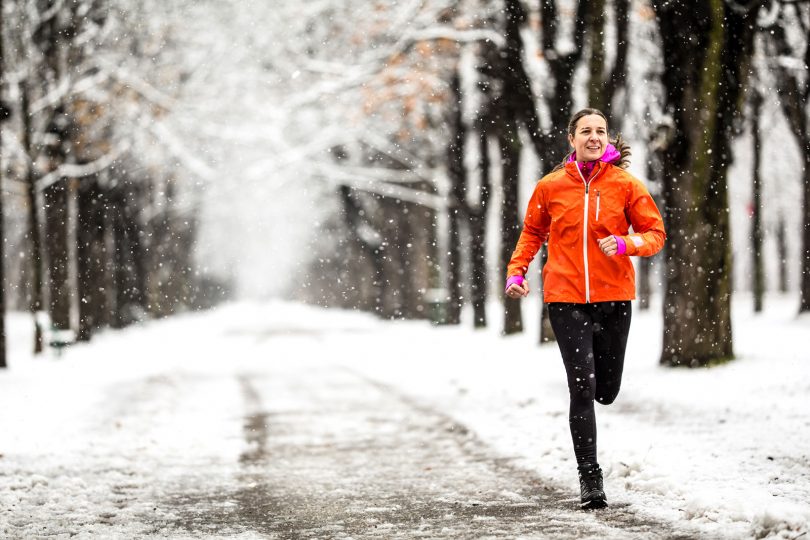Cold weather doesn’t mean you have to give up exercising outdoors. Running on a treadmill or sitting in a spin class has no appeal to some people, even in winter. They just can’t warm up to an indoor workout. The good news is there is no reason to avoid exercising outdoors in the winter, providing you use common sense and follow these 5 winter workout tips. Remember to take a few extra precautions and your winter workouts should be just fine.
5 Winter Workout Tips
1. Wear layers
“Dress for the conditions,” says Karen Kovacs, the clinical director at Pivot Physical Therapy in Hayes, Va., and an orthopedic specialist. “What you wear really does matter with the technology, with the ways brands pull sweat away from your body.”
Proper clothing really is important, agrees Connie Maxwell, co-owner of Village Bicycles in Newport News and a former world-class triathlete and health and physical education teacher. It might take some time to learn what works best for you.
“The first layer should be something that wicks the sweat away so you’re not wet the whole time,” Maxwell says. “From there, depending on how cold it is … wear an outer layer. It could be a shell to protect from the wind.”
Covering your head, hands and feet are important. For cyclists, who sometimes have difficulty keeping their feet warm because of the way the shoes (vented and/or tight-fitting) are made, Maxwell recommends either wool socks or shoe covers.
Avid cyclist Cale Hendricks, an anesthesiologist from Mathews County, suggests wearing items such as hats, gloves and sleeve-warmers that you can take off if you become too hot. Having the right clothing also includes making sure you have dry clothes to change into when you are done exercising. Get those wet clothes off quickly.
2. Warm-up
“The buzzword now is do a little bit of a dynamic warm-up before you start whatever you’re going to do,” says Kovacs, who suggests doing lunges to get ready. Jumping jacks are another good warm-up exercise.
Make sure you ease into your workout to allow your muscles and core body temperature a chance to warm up. That is important for winter workouts because it makes you less prone to injury with limber, loose muscles and joints. In addition, ease into your warm-up.
Remember, the warm-up doesn’t have to be long — just 10 minutes can be a big benefit. However, the length and intensity of the warm-up should correlate to your workout. A harder and longer workout requires a harder and longer warm-up. Some exercise experts suggest increasing the length of the warm-up by five minutes for every 10-degree drop in temperature below 30 degrees.
If you are meeting people for a run or a bike ride, Maxwell suggests staying in your car or house as late as you can. There’s no point standing around in the cold while waiting for others to show up. Also, if it’s extremely cold, you can do your warm-up indoors. But be careful — you don’t want your clothes to be sweaty and wet as you head outside.
You will know if your warm-up is long enough if you have increased your heart rate, are breathing slightly harder and have broken a light sweat.
3. Hydrate
Staying hydrated in the dog days of summer often can be difficult, but it also can be a challenge in the winter.
Not only does the body not get as hot, but sweat also evaporates more quickly in cold air, tricking us into thinking we aren’t losing fluids. Even our thirst response is diminished, so the body starts thinking it’s properly hydrated.
“Even though you don’t think you’re sweating, your body still needs water,” Maxwell says.
“There are a lot of fluid losses that occur with heavy breathing and heavy exercise” even if you don’t sweat, Hendricks agrees. “So you need to replace those fluids … to at least try to head off the dehydration that occurs with heavy exercise.”
A general rule of thumb is to drink about six ounces of water for every 20 minutes of exercise. Just don’t wait until you’re thirsty to drink.
4. Know When to Head Inside
As much as some people hate to work out indoors, there may be times when it’s better to head to the gym. Know your limits, and recognize when going outside isn’t the best idea. No one expects you to clock your daily run in the middle of a blizzard.
“If it’s really cold, like in the 20s and wind chills are below zero,” Maxwell says, “you should consider staying indoors.”
5. Other tips for winter workouts:
- Know the weather conditions and be careful of wind chill. To protect yourself from wind, try running in woods or biking on trails.
- When you start out, either running or biking, you should be a little chilly because you will warm up. For running, dress 20 degrees warmer than it is.
- Wear bright clothing. With limited daylight, people are in a crunch to get in a workout, and that often means being outside when it’s dark.
- Know your route. You don’t want to be out in the cold any longer than planned.
- Start your workout into the wind so when you are coming back in, you won’t freeze.
- Watch for ice and slippery conditions.
Some recommended products:
Balaclava.
Suggestion: Minus33 Merino Wool Midweight Balaclava.
Synthetic socks.
Suggestion: SmartWool Trekking or Hiking crew socks.
Sunglasses, lip balm and sunscreen.
Suggestions: Burt’s Bees Medicated Lipbalm, Kiehl’s Ultra Facial Cream Sunscreen.
Undershirts that wick away sweat and dry quickly.
Suggestion: Under Armor Core Crew undershirts.
Merino wool under layers.
Suggestion: Ibex Wool Woolies
Shoe covers.
Suggestion: Yaktrax Pro Traction Cleats


